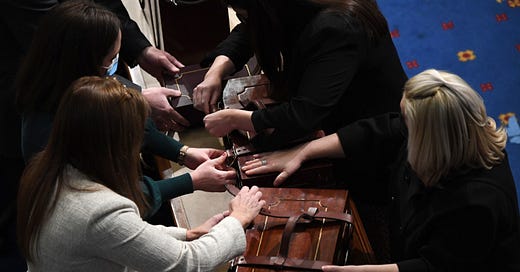
The Electoral Count Act Is a Zero-Day Exploit Waiting to Happen
You shouldn’t be electing a president on the honor system.

Suppose that, instead of using Congress to count electoral votes, we had an Electoral Vote Tally Program, an app that simply added up a state’s electoral votes as they came in. Suppose that the app had a bug in it that allowed anyone watching the vote count to hack into the backend and change the vote totals. Once we’d discovered this flaw, would we ever use this app again without patching it?
Obviously, no. Except that the answer is also “yes.” Because while it was designed by nineteenth-century politicians and not Silicon Valley tech bros, this is an exact description of the system we use to count electoral votes today.
And nobody in either Congress or the White House seems all that concerned with fixing it.
To make matters worse, it’s not just that the Electoral Count Act can be hacked by bad actors attempting to overturn a presidential election’s results. The ECA is, as a legal matter, also full of buggy coding that will cause the entire electoral count system to crash—the constitutional equivalent of the blue screen of death—under certain conditions, even if no one is trying to break it.
What follows is the first in a three-part series on exactly what the ECA is, why it is vulnerable, and how it should be fixed.
According to the Twelfth Amendment,
The person having the greatest number of votes for President, shall be the President, if such number be a majority of the whole number of Electors appointed.
That makes it clear that if, for some reason, a state is unable to appoint presidential electors, the total number of votes required for a majority decreases. For example, if every state and Washington, D.C. appoint electors, there are a total of 538 electors, so 270 votes are required to win the presidency. But if, say, Wyoming failed to appoint electors, the total number appointed would become 535 and only 268 votes would be required to elect a president.
That much is clear. But the wording of the amendment leaves open a number of legal questions:
Suppose Congress legitimately refused to count a state’s electoral votes for some reason. How would you determine a majority then?
If Congress rejects Wyoming’s electoral votes after they’ve been cast, does the number of electoral votes required to win the presidency remain at 270? Or is it reduced to 268?
Does it matter whether the votes are rejected because the electors’ appointments have not been “lawfully certified” (because then the electors would never have actually been legally appointed)? Or whether the electoral votes themselves have not been “regularly given”?
And if it does matter, by what mechanism would Congress make that determination?
And what would happen if Congress couldn’t decide?
The answer to each of these questions is little more than a guess and it’s no use looking in the ECA for the answers. There are none.
Perhaps even worse, it’s unclear from the Twelfth Amendment what happens once the electoral votes have been counted and there is no majority: There is no deadline—in the ECA or anywhere else—by which the electoral votes must be counted.
In other words, if there is extended wrangling about the validity of electoral votes, there will be no elected president or vice president at noon on Inauguration Day, when the outgoing president’s term ends.
At that point, under the terms of the Presidential Succession Act, the speaker of the House would become acting president until a president is elected. But even this is more complicated than it appears, because to be appointed president, the speaker has to resign from Congress, something a House speaker might reasonably be disinclined to do for the pleasure of being president for a few hours or days.
And the same goes for the person next in line, the president pro tempore of the Senate.
The upshot of all this is that in the event that the counting of electoral votes failed to produce a president by January 20, then it is entirely possible that America could end up with the outgoing secretary of state as acting president. Unless, like Henry Kissinger, the secretary of state doesn’t meet the constitutional requirements for the office.
The reason this ambiguity is so dangerous is that hacking the ECA this way doesn’t require unified control of Congress to implement. In fact, it doesn’t even require control of one of the houses of Congress. Under the ECA, one senator and one representative can trigger an objection to a state’s electoral votes that will suspend the electoral vote count until the objection is separately resolved by both houses of Congress. The ECA limits debate to two hours on each objection, but it’s perfectly possible to make more than one objection per state. And there are fifty states, plus the District of Columbia.
So however unlikely it might be, a dedicated band of diehard partisans could use the ECA to block the completion of the electoral vote count past January 20. If this band of diehards had control of one of the houses of Congress? Well, then they could, in theory, block the electoral count permanently.
Don’t think that it can’t happen. Similar tactics have already been applied to block a variety of appointments, including Supreme Court justices.
The ECA does contain provisions which attempt to speed up the consideration of electoral vote objections. But these provisions purport to govern the internal rules and procedures of the House and Senate and a simple majority could vote to ignore them. Even if these provisions could be enforced—and it’s not at all clear that they could—the process would likely take months. Should such a band of diehards control the House, that would make the Diehard-in-Chief—aka the speaker of the House—commander-in-chief for the duration.
Finally, there’s the biggest—and most dangerous—bug of all: Any party that controls both houses of Congress and has the necessary political will can install their candidate as president of the United States regardless of who actually won the election. The unpleasant fact is that, despite a nationwide vote, fenced with elaborate legal and technical safeguards, under the terms of the ECA as it now exists, the president of the United States is elected purely on the honor system by 535 members of Congress.
The ECA is inherently contradictory. It creates a “safe harbor” for electoral votes that have been “regularly given” from states who have appointed electors according to the procedure outlined in the act. So long as there is only a single set of electoral votes from these states, the ECA requires that challenges to these votes be rejected.
But at the same time, the ECA allows Congress to reject electoral votes that it decides have not been “regularly given”—whatever that means—or from electors who it decides have not been “lawfully certified”—even if that is the only slate of electoral votes from a particular state. As a practical matter, this means that Congress is free to reject any state’s electoral votes for any reason at all. All that is required is the votes in Congress and the political will to act.
This flaw in the ECA puts all the angst about voter ID laws in Georgia and the number of dropboxes in Texas into perspective. As important as these issues are, they will impact only close elections and can be overcome simply with more voting. Yes, voting might be harder than it ought to be. But the fundamental rule still applies: Get more votes and you win.
Under the ECA, a party with unified control of Congress can simply discard electoral votes for the other party’s presidential candidate—and this action cannot be challenged.
Read Part 2: “The Crazy, and True, Story of How America Got the Electoral Count Act”
Read Part 3: "Here's How We Fix the Electoral Count Act"









